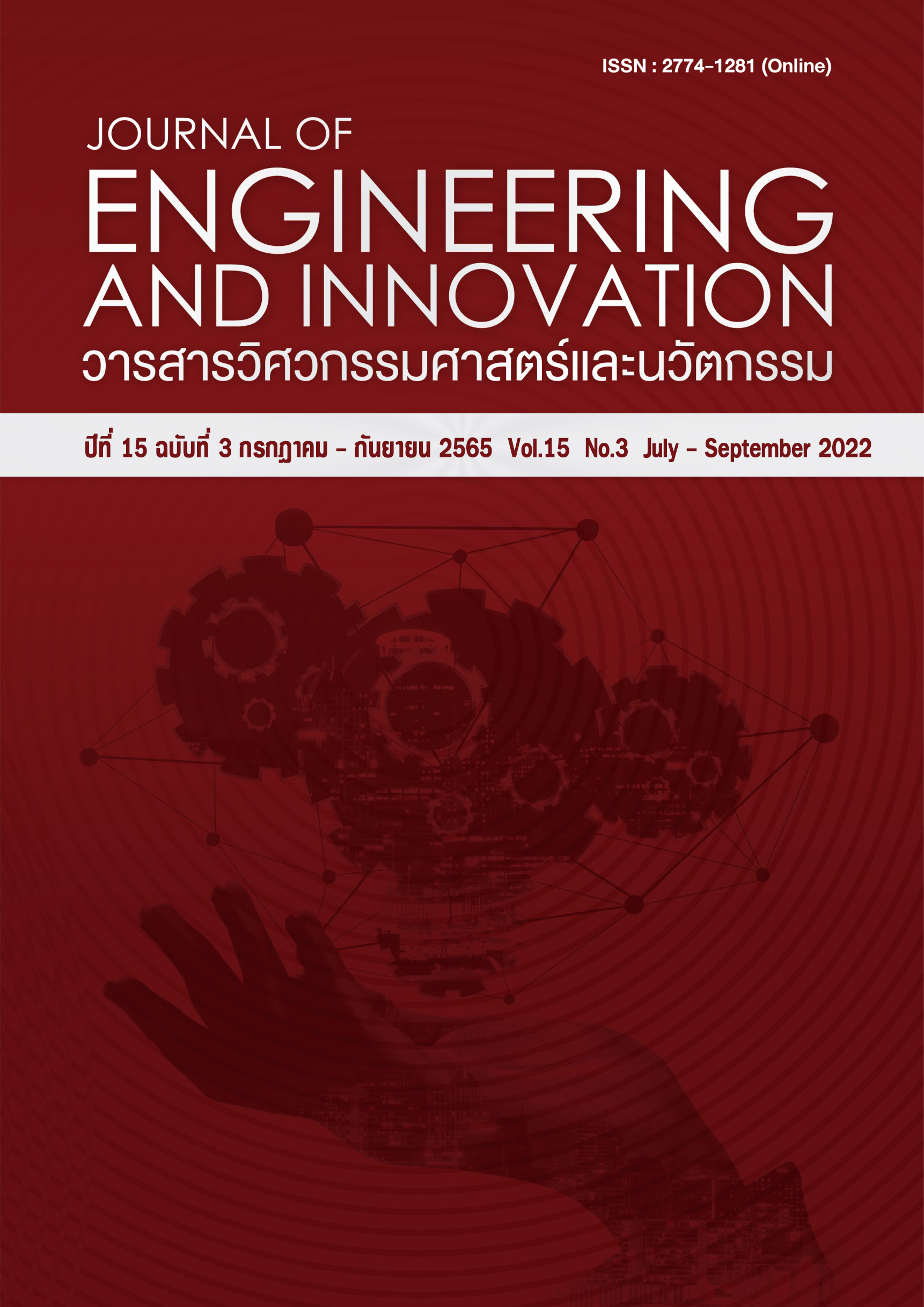Development of rubber speed bumps made of coconut coir dust as filler
Main Article Content
Abstract
This research aims to develop a rubber speed bump product made of coconut coir dust as a filler and utilize the third grade of Rib Smoked Sheet (RSS 3) of 100 parts per hundred of rubber (phr). on coconut coir dust 0, 10, 20, 40, and 80 phr respectively. There were containing Zinc oxide, 5 phr. Stearic acid, 1 phr. Mercaptobenzothiazole (MBT), 0.5 phr. Tetramethylurea disulfide (TMTD), 1.5 phr, Dimethyl butyl phenyl phenylenediamine (6PPD), 1.5 and Sulfur, 5 phr. It was then compounded by two rollers with stock blender rubber and forming by hot compression method at 150 °C for 40 minutes. According to the rubber speed bump of Thai Industry Standard (TIS 2726-2559), the properties were tested. The result revealed that the rubber speed bump made of coconut coir dust as a filler in the ratio of 80 phr had suitable properties for developing the rubber speed bump according to the rubber speed bump of Thai Industry Standard (TIS 2726-2559).
Article Details
References
Lertwattanaruk P, Masuwan K.
Investigation of sound insulation
properties of fiber cement board
containing natural fibers. KMUTT
Research and Development Journal.
;38 (1): 71-86.
Geethamma V, Mathew K, Lakshminara-
yanan R, Thomas S. Composite of short coir fiber and natural rubber, effect of chemical modification. Loading and Orientation
of Fiber Polymer. 1997;1 (39): pp. 1483-1491.
Jacob M, Sabu T, Varughese KT.
Mechanical properties of sisal/oil
palm hybrid fiber reinforced natural
rubber composites. Composites Science and Technology. 2004;64: 955-965.
De D, Adhikari B. The effect of grass fiber filler on curing characteristics and mechanical properties of natural rubber. Polymers for Advanced Technologies. 2004;15: 708-715.
Intharapat P. Filler in natural rubber
from waste biomass. Journal of Science and Technology, Ubon Rachathani University 2012;14(1): 30-43.
Homkhiew C, Ratanawilai T. Optimal proportions of composites from polypropylene and rubberwood flour after water immersion using experimental design, KKU Research Journal. 2014;19 (6), pp. 780-793.
Putra A, Hee K, Selamat MZ, Jailani M, Nor
M, Hassan MH, Prasetiyo I. Sound absorption of extracted pineapple-leaf fibres, Applied Acoustics; 2018: vol. 9-15.
Sajjakulnukit B, Yingyuad R, Maneekhao V,
Pongnarintasut V, Bhattacherya SC, Salam PA. Assessment of sustainable energy potential of non-plantation biomass resources in Thailand. Biomass and Bioenergy; 2005. vol. 214-224.
Srisovanna P. Thailand’s biomass energy. Proceedings of Electricity Supply Industry in Transition: Issues and Prospect for Asia; 2004: vol. 16-35.
Matkaew A, Sangsirimongkolying R,
Boonkerd K, and Rattanapan S. Study
of wastes from agricultural product
processing plants in Nakhon Si Thammarat
province for reusing as filler in rubber
products. Proceedings of the 17th
National Conference and Presentation of Research, Western University. Bangkok. 2020; 17:123-132.
Chusilp N, Laksanakit C, Boonrasri P,
Somboon C Thongkun T. The development of tile roof from disposal Materials. MUTSN Research Journal. 2019;11(1): 41-53.
Tantatherdtam R, Kongtud W, and Sriroth K.
Preparation and properties of natural rubber filled coconut shell and palm oil bunch fiber composites. Proceedings of 48 th Kasetsart University Annual Conference: Agro-Industry. Bangkok (Thailand): The Thailand Research Fund, Bangkok, Thailand. 2010. p. 646.
Joseph S, Joseph K, Thomas S. Green composites from natural rubber and oil palm fiber: physical and mechanical properties. International Journal of Polymeric Materials. 2006; (55): 925–945.
De Taffin G. Coconut: The Tropical
Agriculturalist. Macmillan Education;1998.
Thampan PK, The coconut palm and its
products. Kerala Green Villa Publishing House; 1975.
Barlow WF. Rubber Compounding:
Principles. Materials and Techniques.
(2nded). Florida: CRC Press;1993.
Holfmann WB. Rubber Technology
Handbook. Munich: Hanser Publishers; 1989.
Intharapat P. Filler in natural rubber
from waste biomass. Journal of Science and Technology, Ubon Rachathani University. 2012;14(1): 30-43.
Holfmann. 1989. WB., Rubber Technology
Handbook. Munich. Hanser Publishers.
Subramanium A. Molecular weight and
molecular weight distribution of natural rubber. RRIM Technology Bulletin. 1980; 4: 1-25.
Dupont. Compare EVA Grades and
Performance Properties. Delaware:
E.I. du Pont de Nemours and company. 2012.
Bledzki AK, Gassan J. Composites reinforced with cellulose based fibers. Progress in Polymer Science. 1999;24: 221-274. http://dx.doi.org/10.1016/S0079-6700(98)00018-5
Sirisinha C. Jitkanakarn J. Sae-Oui P. The effect of mixed silica and carbon black on mechanical properties of isoprene rubber. 27th Congress on Science and Technology of Thailand. 2001: 868.
Boonthee A, Srimook S, Sinsin PU, Rayoyoi S, Saikaew S. The Influence of Coconut Fiber Effect on Mechanical Properties of Natural Rubber. Proceeding of The 6th National Academic Conference. Rajabhat Village Chom Bueng Research. 2018;42(6): 34-41.
Raksarak N, Ratanawilai T, Srivabut C.
Effects of the use of natural fibers from agricultural wastes on mechanical, physical and Thermal Properties of wood plastic composites from polypropylene. KMUTT Research and Development Journal. 2019;42(4): 328-338.
Kuo PY, Wang SY, Chen JH, Hsueh HC, Tsai MJ. Effects of material compositions on the mechanical properties of wood plastic composites manufactured by injection molding. Materials and Design; 2009;30 (9): 3489–3496.
Yantaboot K. Kaewarsa P. Physical Properties of natural rubber foam reinforced with borassus fruit fiber: effects of alkali treatment and fiber content. Journal of Science and Technology Ubon Ratchathani University. 2020;22(3): 75-81.
Srisen, A. Tangchirapat W. Jaturapitakkul.
C. 2014, Properties of concrete using fly ash and calcium carbide residue as a cementitious material, KMUTT Research and Development Journal, 37 (2): 165-175. (In Thai)
Bumrungsri C. Tangchirapat. W. Jaturapitakkul C. Development of concrete block made from waste materials without portland cement. Proceeding of Annual Concrete Conference 7, 2011;19-21 October, Rayong Resort Hotel, Rayong, MAT138-143. (In Thai)

